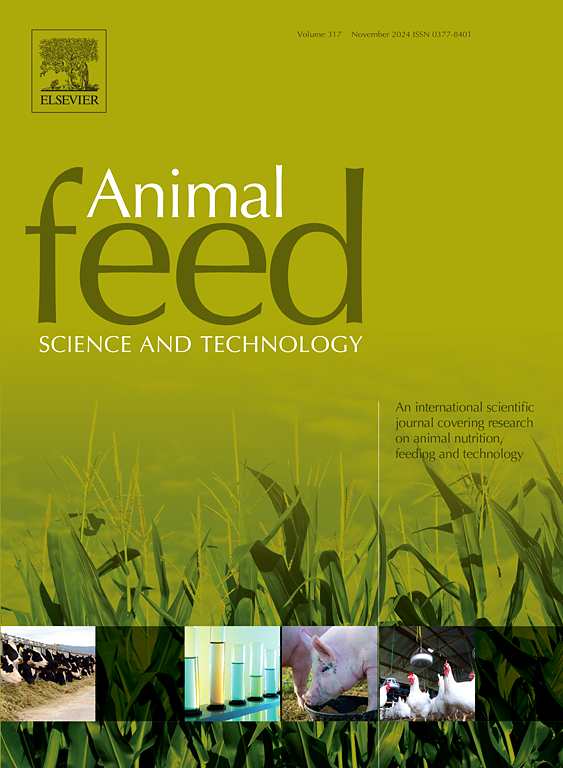预测生长猪饲喂的中国稻米的可利用能量和氨基酸消化率
IF 2.5
2区 农林科学
Q1 AGRICULTURE, DAIRY & ANIMAL SCIENCE
引用次数: 0
摘要
我们进行了两项实验来测定生长猪中国稻米中粗蛋白(CP)和氨基酸(AA)的可消化能(DE)、可代谢能(ME)和标准化回肠消化率(SID),并根据其化学成分(包括淀粉酶处理过的中性洗涤纤维(aNDF)、酸性洗涤纤维(ADF)和钙(Ca))建立可消化能(DE)、可代谢能(ME)和粗蛋白(CP)和氨基酸(AA)的标准化回肠消化率(SID)的预测方程。在实验 1 中,选取了 24 只阉割公鸡(20 ± 1.3 千克),并对其进行了 12 × 3 不完全拉丁方形重复设计,包括 12 种日粮和 3 个连续饲喂期。基础日粮和 11 种中国稻米日粮的玉米和豆粕比例保持一致。每个阶段有 7 天的适应期和 5 天的粪尿收集期。在实验 2 中,24 头回肠封罐猪(15.4 ± 1.8 千克)采用重复的 12 × 3 不完全拉丁方形设计,其中有 12 种日粮和三个连续的时期,每个时期有 5 天的适应期和 2 天的回肠消化液收集期。在 11 种试验日粮中,中国水稻是唯一的氮(N)来源,无氮日粮用于计算基础内源氮损失。结果表明,中国稻米中的DE和ME值(按饲喂量计算)平均分别为12.17兆焦/千克和11.57兆焦/千克。DE 和 ME 的最佳预测方程分别为 DE (MJ/kg) = 20.12 - (0.56 × aNDF, %) + (130.01 × Ca, %) - (3.94 × phytic acid, %); R2 = 0.94, RSD = 0.44, P < 0.001,ME (MJ/kg) = -0.263 + (0.972 × DE, MJ/kg); R2 = 0.96, RSD = 0.32, P < 0.001。中国水稻中 CP(SIDCP)、Lys(SIDLys)、Met(SIDMet)、Thr(SIDThr)和 Trp(SIDTrp)的 SID 值分别为 0.735、0.766、0.687、0.736 和 0.862。SIDCP、SIDLys 和 SIDThr 的最佳拟合方程为 SIDCP = 0.67 - (0.03 × ADF, %) + (0.06 × CP, %); R2 = 0.79, RSD = 0.04, P = 0.002, SIDLys = 1.18 + (4.34 × 非植酸态磷, %) - (6.71 × Trp, %) - (6.59 × Ca, %); R2 = 0.93, RSD = 0.03, P < 0.001,以及 SIDThr = 0.82 + (2.88 × Met, %) - (1.61 × Lys, %); R2 = 0.83, RSD = 0.03, P = 0.001。总之,我们的研究揭示了中国稻米的化学成分与生长猪的 DE、ME 和前四种限制性 AA 的 SID 之间的关系,建立了生长猪饲喂中国稻米营养价值的预测模型。ANDF、ADF、植酸、植酸磷、非植酸磷、总磷、CP 和 Ca 是预测 DE 和 ME 的共同关键因子。干物质、aNDF 和 ADF 是 SIDCP 和 SIDLys 的共同关键预测因子。粗纤维、ADF 和 Met 可作为 SIDThr 的单一预测因子。本文章由计算机程序翻译,如有差异,请以英文原文为准。
Prediction of available energy and amino acid digestibility in the Chinese paddy rice fed to growing pigs
Two experiments were conducted to determine digestible energy (DE), metabolizable energy (ME), and standardized ileal digestibility (SID) of crude protein (CP) and amino acids (AA) in Chinese paddy rice for growing pigs, and to establish prediction equations for DE, ME and SID of CP and AA based on its chemical composition including amylase-treated neutral detergent fiber (aNDF), acid detergent fiber (ADF), and calcium (Ca). In Exp. 1, twenty-four castrated barrows (20 ± 1.3 kg) were selected and allotted to a replicated 12 × 3 incomplete Latin square design, including 12 diets and 3 consecutive periods. A basal diet and 11 Chinese paddy rice diets were prepared and maintained a consistent ratio of corn to soybean meal. Each period had 7 d of adaptation and 5 d of fecal and urine collection. In Exp. 2, twenty-four ileal-cannulated pigs (15.4 ± 1.8 kg) were used in a duplicated 12 × 3 incomplete Latin square design with 12 diets and three consecutive periods, and each period had 5 d of adaptation and 2 d of ileal digesta collection. Chinese paddy rice was the sole nitrogen (N) source in 11 test diets, and an N-free diet was used for calculating the basal endogenous N losses. The results revealed that DE and ME values (as-fed basis) in Chinese paddy rice averaged 12.17 MJ/kg and 11.57 MJ/kg, respectively. The optimal prediction equations for DE and ME were DE (MJ/kg) = 20.12 − (0.56 × aNDF, %) + (130.01 × Ca, %) − (3.94 × phytic acid, %); R2 = 0.94, RSD = 0.44, P < 0.001, and ME (MJ/kg) = −0.263 + (0.972 × DE, MJ/kg); R2 = 0.96, RSD = 0.32, P < 0.001, respectively. The values for SID of CP (SIDCP), Lys (SIDLys), Met (SIDMet), Thr (SIDThr), and Trp (SIDTrp) in Chinese paddy rice were 0.735, 0.766, 0.687, 0.736, and 0.862, respectively. The best-fit equations for SIDCP, SIDLys, and SIDThr were SIDCP = 0.67 − (0.03 × ADF, %) + (0.06 × CP, %); R2 = 0.79, RSD = 0.04, P = 0.002, SIDLys = 1.18 + (4.34 × non-phytate phosphorus, %) − (6.71 × Trp, %) − (6.59 × Ca, %); R2 = 0.93, RSD = 0.03, P < 0.001, and SIDThr = 0.82 + (2.88 × Met, %) − (1.61 × Lys, %); R2 = 0.83, RSD = 0.03, P = 0.001, respectively. In conclusion, our study revealed the relationships between the chemical composition of Chinese paddy rice and DE, ME, and the SID of the first four limiting AA for growing pigs, establishing the predicted models for the nutritive value of Chinese paddy rice fed to growing pigs. The aNDF, ADF, phytic acid, phytate phosphorus, non-phytate phosphorus, total phosphorus, CP, and Ca were the common key predictors for DE and ME. Dry matter, aNDF, and ADF were the common key predictors of SIDCP and SIDLys. Crude fiber, ADF, and Met can be the single predictors of SIDThr.
求助全文
通过发布文献求助,成功后即可免费获取论文全文。
去求助
来源期刊

Animal Feed Science and Technology
农林科学-奶制品与动物科学
CiteScore
6.00
自引率
6.20%
发文量
266
审稿时长
3 months
期刊介绍:
Animal Feed Science and Technology is a unique journal publishing scientific papers of international interest focusing on animal feeds and their feeding.
Papers describing research on feed for ruminants and non-ruminants, including poultry, horses, companion animals and aquatic animals, are welcome.
The journal covers the following areas:
Nutritive value of feeds (e.g., assessment, improvement)
Methods of conserving and processing feeds that affect their nutritional value
Agronomic and climatic factors influencing the nutritive value of feeds
Utilization of feeds and the improvement of such
Metabolic, production, reproduction and health responses, as well as potential environmental impacts, of diet inputs and feed technologies (e.g., feeds, feed additives, feed components, mycotoxins)
Mathematical models relating directly to animal-feed interactions
Analytical and experimental methods for feed evaluation
Environmental impacts of feed technologies in animal production.
 求助内容:
求助内容: 应助结果提醒方式:
应助结果提醒方式:


